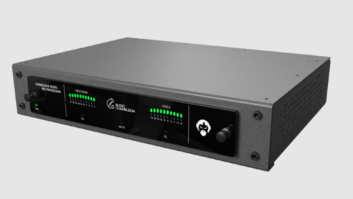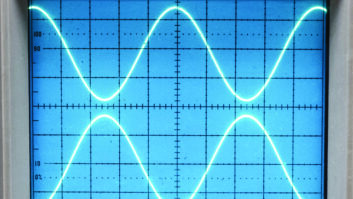
BiLi Showcase at IBC 2013 in Amsterdam
PARIS — A consortium in France has come together for an experimental research project concentrating on binaural listening.
The BiLi project is led by France Télévisions, and involves Radio France, the Research Institute and Coordination Acoustics/Music (IRCAM), Orange Labs, the Conservatoire National de Musique de Paris, the CNRS-Laboratory of Computing for Mechanics and Engineering Sciences (Limsi) and four medium-sized firms: Trinnov Audio, Digital Media Solutions, Arkamys and A-Volute.
After a series of meetings between Radio France, France Télévisions and IRCAM in early 2011, the consortium expanded and was granted funding under the French government’s Fonds Unique Interministériel program. BiLi started its three-year trial in January 2013.
As an initial result of BiLi’s developments, Radio France’s new website, NouvOson, now offers multichannel audio to listeners around the world who are equipped with surround sound home cinema speakers, or they can enjoy access to binaural 3D audio listening through stereo headphones.

Website NouvOson highlighted on BiLi’s booth during IBC2013.
SPATIAL PERCEPTION
Today, most Internet browsers and mobile players will decode multichannel HE-AAC content to restore the audio space in its traditional horizontal stereo plan, but binaural audio adds additional spatial information to create a more open soundscape. This is the first step toward 3D audio.
BiLi’s binaural audio is based on advanced algorithms, which imitate the human perception of sound, explains Radio France Sound Engineer Hervé Déjardin, in charge of BiLi for production and broadcasting multidimensional content, within the Quality and Innovation Section headed by Edwige Roncière.
In an experimental laboratory, where François Ragenard handles audio encoding, artists mainly use multichannel recording gear, DPA 5100 mobile surround mics, plus two Yamaha DM1000 digital mixers. A new mobile control room, designed for multichannel applications has a Lawo MC266 mixer with Dynaudio Acoustics monitors at its heart.
“The results from research carried out by BiLi’s partners are used to reproduce binaural listening by modifying the stereo flow, which feeds the listener’s headphones, to fit the morphological parameters defining his or her spatial perception,” said Déjardin.

An experimental system, based on Ambisonics and High Order Ambisonics technology during a Traviata video recording at the Rennes Opera House in May 2013. “Many factors influence how humans perceive audio space — sound reaching one ear faster than the other; tens of microseconds for the brain to track the spatial location of the audio source, whose accuracy is bound to vary from five to 10 degrees; the configuration of the auricle; and the shape of the face or skull, which alters the reflection of the tone of a sound.”
Déjardin explains that spectral audio cues stored in a human’s brain since early childhood, and gradually adjusted to one’s evolving morphology, make it possible for a person to distinguish a spherical hearing field of 360 degrees. “This is an accurate factor to be taken into account when elaborating algorithms.”
Binaural audio thus exploits these perception variables based on the temporal and spectral variations of intensities in order to reproduce sounds deriving from afar or close by, from the front or back, top to bottom, promising perfect full 3D audio reproduction.
IMPROVE QUALITY

BiLi Logo “Olivier Warusfel, of IRCAM, highlighted the possibility to individualize these morphological configurations in order to obtain better reproduction of 3D space and to improve audio, music content,” according to Déjardin.
He explains that, together with Matthieu Parmentier, R&D project manager at France Télévisions Innovation & Développement and Catherine de Boishéraud, Audiovisual Unit director at the Conservatoire National de Musique de Paris, they initiated the BiLi consortium.
“The Director of Radio France’s New Media Department, Joël Ronez, supported the project and created the NouvOson website in March 2013 with an objective to generating in-house content with this new audio approach. Radio France’s 24-hour news channel France Info is studying ways to better provide information via 3D audio reporting. Broadcasting multichannel content — reports, documentaries, music — offers an immersion into a 360 degree audio field that is still unexploited,” says Déjardin.
BiLi’s website showcases a selection of Radio France binaural productions. The broadcaster’s sound engineers individually visit the laboratory for binaural initiation.

France Télévisions Logo AUDIO STAGE
In February 2013, the BiLi consortium organized a public demonstration of real binaural audio listening at the Gaîté Lyrique theatre in Paris. The audience was equipped with headphones and Radio France Sound Engineer Pascal Besnard carried out a 5.1 mix on the console. He encoded the audio for binaural listening via headphones. Whereas stereo restricts space, the binaural process presents the audio sources with much better realization of the audio stage, says Déjardin.
The NouvOson website will soon broadcast its programs as a single multichannel file fit for separating channels (for home cinema listening) and for generating a binaural “stereo” output (for headphone listening). The only requirement for listeners is that they install a “binauralization plug-in” on their browser. Later, the application will customize the binaural process for every listener.
In addition, last June, during the France 2 TV program “Ce soir ou jamais,” the BiLi consortium carried out for the first time a 360 degree video recording of the show, which is rich in audio content.
During the recording, mics were simultaneously placed in various points on the set, and the six images of the video recording were harmonized into a single video to 360 degrees, as well as 48 microphones recorded on one multitrack combined with an mh acoustics Eigenmike, a high-order Ambisonics sphere of 32 mics to capture the audio atmosphere in three dimensions.

IRCAM Logo
THE STEPS
This three-year experimental project includes a number of steps: the appraisal of the audio listening quality, the production of contents, the standardization of a storage and exchange format for Head-Related Transfer Functions, the individual morphological data which adapt the brain to 3D audio perception (HRTF), the creation of acquisition methods of morphological data and the creation of reception maps for a personalized restoration of binaural listening. The overall objective is to be manufacturing equipment by 2015.
To promote its achievements, the BiLi consortium has participated in a number of public demonstrations: IBC2013 in Amsterdam last September, Radio 2.0 in Paris last October, International Forum of Multichannel Sound (FIMS) in November at Radio France, Web’13 in December in Paris.

Radio France Logo Events planned for early 2014 include the Symposium Technologique du Conservatoire de Paris in March and the NAB Show in Las Vegas in April. The consortium is also working with other European partners, including the BBC and the European Broadcasting Union, and also co-organizes industry conferences and workshops, most recently in Geneva with Fraunhofer, Dolby, DTS and Auro Technologies.

Logo of Conservatoire National de Musique de Paris Eager to extend binaural audio, Déjardin and his partners are now looking toward European cooperation in creating a new three-dimensional audio recording and playback format.
Emmanuelle Pautler reports on the industry for Radio World from Paris.
For information on the BiLi project, contact Hervé Déjardin at [email protected].












